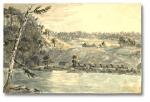The Battle of Queenston Heights, 1812 (Single lesson)
The Mission
Imagine you are in October 1812 in Upper Canada (Ontario).
Since June 18, the United States of America have officially declared war on Great Britain and its North American colony of Canada. At the centre of the conflict are: (1) European trade barriers between Great Britain and France (Orders-in-Council) resulting in American vessels – trading with both countries regardless of the blockade – being seized by the British Navy; (2) and American expansionist visions of Republican Congressmen and frontiersmen who oppose British-Canadian presence in North America as well as their support for Aboriginal peoples in the Great Lakes region, notably the Shawnee chief Tecumseh.
Attacking Canada was seen by American "War Hawks" as a straightforward and necessary strategy to defend the interests and sovereignty of the United States by defeating Great Britain in North America. Former American President Thomas Jefferson was convinced that victory would be a formality. "The acquisition of Canada," he infamously proclaimed, "will be a mere matter of marching...."
As part of a plan to invade Canada and avenge the taking of Fort Detroit in August 1812, 6000 American troops under the command of General Stephen Van Rensselaer launched a surprise attack on the morning of October 13. The objective is the village of Queenston Heights strategically located on the Niagara River, just across from Fort Gray. Initially successful, the American attempt to capture the Canadian village is ultimately repulsed by British General Isaac Brock and his 2000 regular and militia troops and Indian allies. Over 300 American soldiers were killed or wounded in the battle and nearly 950 were taken as prisoners. On the Canadian side, 14 were killed, including General Brock and his aide-de-camp, Colonel Macdonell.
One key witness of the whole battle of Queenston Heights was Canadian militiaman Archibald McLean who enrolled as an officer with the 3rd York Militia and wrote a detailed account of the famous battle.
How did the Battle of Queenston Height unfold?
Based upon the historical sources, including the original letter of Archibald McLean written on October 15, 1812, recreate the famous scene of the battle of Queenston Heights.
Tasks
1. Examine the geographical map of Queenston and the Niagara region, and identify and locate relevant information concerning the Battle of Queenston Heights, including photographs of the area.
2. Read carefully the letter of Militiaman Archibald McLean and note key passages dealing with the battle.
3. Using British/Canadian and U.S. drag-and-drop military "figures" from the margin (soldiers, troops, transportation boats, canons, generals), recreate the scene of the battle based upon your interpretation of the letter.
4. When completed, compare and contrast your work with the historical one produced in 1836.
5. Explain the similarities and differences between your work and the one of 1836
6.What could account for these similarities and differences? (interpretation, use of different sources, bias, positionality, etc.)
7. Is the original work of 1836 necessarily "more accurate" than yours? Explain your answer
To acheive your objective, you need to use primary source as evidence. To know more about the concept of "primary source evidence" in history consult The Historical Thinking Project
See Rubrics for specific expectations.
